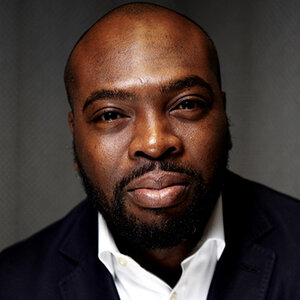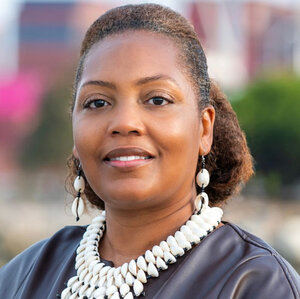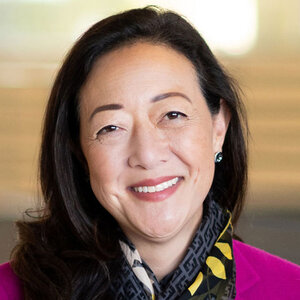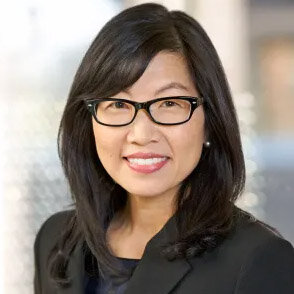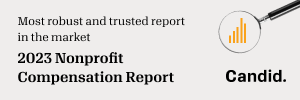Ludovic Blain, Executive Director; Rebecca Hamburg, Chief Network Officer, California Donor Table: Addressing an underlying failure in philanthropy
October 12, 2023
California Donor Table (CDT) is a statewide community of donors who pool their funds to invest in organizations and leaders that reflect and represent the full diversity of the state to advance progressive movement spanning issues and constituencies. The organization comprises three separate, aligned entities: California Donor Table, a 501(c)(4) fiscally sponsored by Tides Advocacy, California Donor Table Fund (CDTF), a 501(c)(3) fiscally sponsored by Tides Center, and Progressive Era Project, an independent California nonprofit public benefit corporation.
Ludovic Blain was hired as CDT's first full time staff person in 2009, after leading efforts to build people of color-centered movements around closing the racial wealth gap, environmental justice, media justice, campaign finance, and voting rights. Under his leadership, the CDT family of entities has mobilized more than $50 million to build and sustain progressive people of color-centered policy and political power building and wielding across California.
Rebecca M. Hamburg is the chief network officer for CDT; she leads individual donor network strengthening and expansion as well as foundation engagement and alignment work for CDT/F. She was the founder and principal consultant for Rebecca Hamburg Consulting, where she provided guidance to grantmakers on how they can support and engage in advocacy and other nonprofit organizations to engage their communities in public policy efforts through an understanding of federal tax and election law.
PND asked Blain and Hamburg about what election-related activities different types of foundations and charities can and cannot fund, what the most effective strategies are, and why it’s important to support community-based grassroots organizing groups in communities of color and low-income communities.
Philanthropy News Digest: Institutional philanthropy traditionally has tried to steer clear of politics even as it sought to help bring about “social progress.” What role might philanthropy play today to strengthen democracy and advance racial equity and justice?
Ludovic Blain: Philanthropy is legally required to steer clear of partisanship, meaning working for or against candidates and political parties. Conflating that with steering clear of anything political is an underlying failure in philanthropy, especially liberal philanthropy.
At a time when fascists are pushing policies that strip hard-earned rights away from the majority of the population, avoiding issues that have been made “political” prevents philanthropy from tackling effective strategies to eradicate racism and other forms of oppression, as well as basic methods of strengthening democracy. In other words, if slavery was still legal in America, and one party advocated to keep it, would philanthropic efforts opposing it be considered “political”? We’re fighting the modern equivalent in battles for gun control, access to abortion, voting rights, and gender-affirming health care.
Philanthropy is legally required to steer clear of partisanship, meaning working for or against candidates and political parties. Conflating that with steering clear of anything political is an underlying failure in philanthropy, especially liberal philanthropy.
Only liberal philanthropy resists funding activities they perceive as political. Much conservative philanthropy is explicitly aligned not only with conservative advocacy (such as hundreds of million dollars in Koch Brothers funding for the NRA and against gay marriage and abortion rights) but also with conservative partisan organizations.
If philanthropy was doing its job right, we’d be living in an era of expanding rights to health care, religious freedom, education, and most critically access to voting, rather than of diminishing rights for those with less power. Therefore, philanthropy’s role in strengthening democracy, at least for those philanthropists whose goal is to do so, is to invest in national, state, and regional groups that build power for under-resourced communities.
While voter turnout among people of color and young people is improving, our national electorate continues to track with our exclusionary history. U.S. voters skew white, older, landowning, native-born, and married compared to the eligible voter population overall.
PND: There is a widespread (mis)perception that foundations and grantmaking charities are legally prohibited from supporting any political or election-related activities. What types of activities are they actually allowed to and not allowed to fund?
Rebecca Hamburg: Dispelling this myth is something we work hard to overcome every day. The fact is that foundations and grantmaking charities tend to be risk-averse. We need the philanthropy sector to better understand legal allowances that best support movements and power building, rather than rejecting political and election-related activities wholesale.
Laws apply to each type of philanthropic entity in different ways:
The fact is that foundations and grantmaking charities tend to be risk-averse. We need the philanthropy sector to better understand legal allowances that best support movements and power building, rather than rejecting political and election-related activities wholesale.
Private foundations like Ford, Hewlett, etc. can fund public charities to engage nonpartisan advocacy and engagement activities such as voter education and mobilization, civic engagement, policy research and analysis, advocacy on issues raised by that research, and some voter registration activities with limitations. Bolder Advocacy has a factsheet with more information on private foundation allowances and limitations.
Family foundations with living donors have a unique opportunity, as both the Heising-Simons and Grove foundations have done, to start a 501(c)(4) entity, a “social welfare organization” that awards grants in coordination with their (c)(3) giving. In this case, their (c)(3) foundations can make grants for education and advocacy around reproductive justice issues, while their (c)(4) foundation can issue grants around ballot initiatives and legislative lobbying activities.
Public foundations, like community foundations, are essentially grantmaking nonprofits—they have multiple sources of income, and don’t have as many hurdles to jump. Like other public charities, they have a lobbying limit, which means they can fund advocacy work more robustly than their private foundation counterparts and provide grants directly to 501(c)(4)s or even earmark their grants to public charities for lobbying. This means public foundations can also directly support or oppose ballot initiatives, which is considered a lobbying activity under federal rules.
PND: What types of initiatives can philanthropy support most effectively without being “partisan”?
RH: In an election year, philanthropy can support expanding voter engagement, often called integrated voter engagement, candidate debates, policy proposals, as well as election protection activities. They can even directly support election administration in many jurisdictions.
In non-election years, in addition to integrated voter engagement, philanthropy can support policy development and advocacy, as well as governing support for elected officials.
PND: Where are the opportunities, and what is the strategy, for partisan multi-entity giving beyond (c)(3) organizations?
RH: Though private and public foundations are prohibited from engaging in partisan activities, individual donors and 501(c)(4) social welfare organizations, 501(c)(5) unions, and 501(c)(6) trade associations, can fund and engage in partisan activities as long as they are not their primary activity. Where possible, donors should be diversifying their funding portfolios with robust 501(c)(4) investments, either directly to aligned candidates or to organizations engaged in partisan activities.
The rest of philanthropy can maximize giving to (c)(3)s by ensuring that they are giving as much general operating support as possible, and utilizing tools like the specific project grant rule to support organizations that lobby.
California Donor Table is the oldest donor network in the country that invests in political power and civic engagement across all tax statuses—including 501(c)(3)s, 501(c)(4)s, and PACs—while centering racial equity and justice. Achieving systems change in a state like California requires sustained and diversified funding, year-round. We are a family of entities with multiple tax statuses to allow us to power the widest range of political and civic engagement efforts possible.
PND: Why is it particularly important to support community-based grassroots organizing groups focused on civic education and engagement in communities of color and low-income communities?
LB: According to the Freedom in the World score, the strength of U.S. democracy dropped 11 points in the last 10 years, due robustly to aligned conservative philanthropic and political giving to organizations, candidates and political entities seeking to expand corporate power, re-center straight Christian white males in politics and policy making. Part of their strategy has been to widen gaps in American democracy—including increasing the influence of money in politics, promoting partisan gerrymandering, and expanding barriers to voting.
Elections funded primarily by wealthy white donors mean that candidates as a whole are less likely to prioritize the needs of people of color and that candidates of color are less likely to run for elected office, raise less money when they do, and are less likely to win. Ultimately, people of color are not adequately represented by elected officials.
We envision a world where we all have stable homes, well-funded schools, access to health care, and can rest with trust that our votes and civic engagement help shape our democracy. The way we get there is by investing in power building organizations that turn out voters of color; our network of donors are transforming electorates and elections in San Diego, Central Valley, and Orange County, Los Angeles, and Alameda. Our model has inspired state-based donors to invest heavily in states with rising majorities of people of color like Georgia and Texas and across the country.
We envision a world where we all have stable homes, well-funded schools, access to health care, and can rest with trust that our votes and civic engagement help shape our democracy. The way we get there is by investing in power building organizations that turn out voters of color
PND: California Donor Table invests “in communities of color so they have the power and resources they need to (1) elect people who represent their values and needs and (2) help govern and hold decision-makers accountable,” and in 2022 helped elect two Black progressive women district attorneys in the Bay Area. Are you optimistic that more institutional philanthropic funding for the activities they are allowed to fund will help elect more candidates of color?
LB: We’re absolutely optimistic that nonpartisan philanthropic funding strengthens communities of color’s ability to elect candidates that will represent their interests, including candidates of color. In the last few years, California has elected dozens of progressive women of color to critical leadership positions including Los Angeles mayor Karen Bass, state senator Aisha Wahab, state assembly member Eloise Gomez Reyes, and DAs Pamela Price and Diana Becton–and many more county supervisors, city council members and school board members.
Beyond candidates, we played a role in the 17 point increase in youth voter turnout from 2016 to 2020, a steady increase in voter of color participation from 2016-2020, and historic voter turnout in 2020.
We also have provided initial and usually sustained funding to key regional and statewide voter engagement groups rooted in communities of color including the Working Families Party, California Environmental Justice Alliance Action, Communities for a New California, Alliance San Diego, Inland Empire United, Lift Up Contra Costa, Bay Rising Action.
We have also funded many of those groups to run key regional ballot initiatives that increased the power of voters through shifting from at-large to district elections, mandating fall local elections, and instituting Democracy Dollars.
PND: Are there efforts philanthropy can support after elections to help ensure long-term change and accountability?
RH: That’s where philanthropy can be most helpful. Partisan funds can elect a good candidate to office, but can’t support them while they are in office. Philanthropy can ensure that once elected, leaders aligned with those who hold less traditional forms of power (communities of color, youth, renters, minimum wage workers, refugees, etc.) can govern effectively in spite of organized opposition.
How? Philanthropy can fund institutions that share resources for elected leaders who prioritize community involvement, co-governance and accountability, such as Local Progress, State Innovation Exchange, Boards & Commissions Leadership Institute, Government Alliance on Race and Equity, as well as consultants like Andrea Batista Schlesinger and Kathleen S. Morris who work directly with elected officials.
Philanthropy can also support expanding the number of BIPOC, women, LGBTQIA+, and young people entering public leadership by funding intersectional, nonpartisan public leadership pipeline work, aligned with power-building movements.
Kyoko Uchida is managing editor at Philanthropy News Digest.


